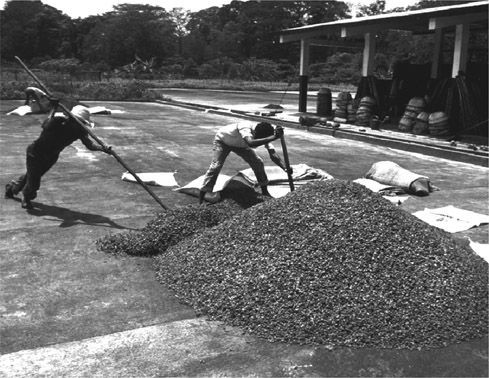A solid, sweet delicacy made from the powdered cacao bean that can be traced to the earliest civilizations of Mesoamerica and their use of cocoa paste as a base for beverages, pharmaceuticals, stimulants, and aphrodisiacs.
The use of cocoa powder to produce a beverage has endured time. Tastes and ingredients may have changed, but the basic component of the drink, chocolate powder or paste, has not. Its name has changed from the Mayan “ka-ka-wa,” to the Aztec “cacao,” and now the Spanish word “chocolate” is used.

Originally invented by the Aztecs, chocolate has been a major commodity of world trade ever since the Spanish imported it from Mexico in the sixteenth century. Here, cacao beans, from which chocolate is made, are being prepared for export in Venezuela. (© Rob Crandall/The Image Works)
Native to the tropical lowlands of Latin America, the cacao plants (Theobroma cacao) produce thirty fruit or cacao beans; the rarity of these beans led to their being used to barter for goods. The Mayan, Aztec, and Mexican cultures in these regions were fond of hot, bitter, and spicy drinks; and, to that end, would add chilies, lime water, bitter flowers, and seeds to their cocoa paste to form a pungent beverage—a remedy for fevers, chest complaints, or to build strength. Green fermented, cacao beans were added to Psilocybe mexicana, a hallucinogenic mushroom, to produce an intoxicating drink or love potion with a psychedelic effect.
Ancient civilizations of the Americas, such as the Olmecs, prepared foamy chocolate drinks by pouring a liquid chocolate mixture from pot to pot. A spout-shaped vessel, dated 600 B.C.E. and used to pour chocolate, was discovered in Colha, Belize. The pot was linked to chocolate by the presence of the molecule theobromine.
Later, Mayans and Aztecs began to experiment by adding honey and vanilla to cocoa powder to produce a sweeter taste, and, in Mexico, nuns added cane sugar, which was much more indigenous to their region. These were the earliest versions of the chocolate drinks that are enjoyed today.
Christopher Columbus introduced chocolate to Europe in 1502 after an encounter with Mayan traders. Cacao beans provided the first stimulant to gain widespread acceptance in European countries and one of Mesoamerica’s main exports. It was the sweeter version, or Catholic drink, made with water, sugar, cinnamon, and vanilla, that became popular among the religious as well as the aristocracy in Spain.
In the late 1500s, the pleasure of drinking chocolate was no longer restricted to the elite. Average citizens of Spain and Italy could savor this wonderful drink. By the early 1600s, cacao beans were exported to Germany, Holland, and France.
The water in chocolate beverages was replaced with milk, and the first cocoa processing factories were opened in England, France, and the United States during the 1700s. In the 1800s, Holland and Switzerland perfected a process to manufacture milk chocolate; but the Swiss, with their high-quality milk, perfected an excellent solid-bar, milk chocolate.
Production and distribution controls surfaced as the trade in cacao beans became more prominent between Mesoamerica and Europe. Today, cacao beans are traded on the London and Chicago commodities exchanges. In the past, the quality of cacao bean crops caused fluctuations in the price of chocolate. Recently, vegetable oil has become an acceptable substitute for cocoa butter. As a result, the current world price of chocolate is determined more by the price of milk and sugar.
Marilyn Cottrell
See also: Aztecs; Discovery and Exploration; Food and Diet; Globalization; Religion; Spices.
Bibliography
Flandrin, Jean-Louis, and Massimo Montari, eds. Food: A Culinary History from Antiquity to the Present, trans. Albert Sonnenfeld. New York: Columbia University Press, 1999.
Pomeranz, Kenneth, and Steven Topik. The World That Trade Created: Society, Culture, and the World Economy, 1400–the Present. Armonk, NY: M.E. Sharpe, 1999.
Rubinstein, Helge. The Chocolate Book. Harmondsworth, UK: Penguin, 1982.
